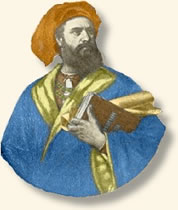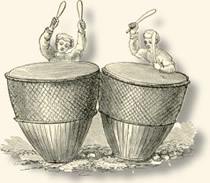|
Kublai Khan In Battle, 1287
In the middle 13th century the influence of the Mongol Empire established by Genghis Khan stretched from the borders of Poland in the West to the Yellow Sea in the East. Kublai Khan, grandson of Genghis, became ruler of the empire in 1260 and proceeded to consolidate his power by relinquishing the Mongol conquests outside China establishing his capital at the site of modern-day Beijing.

Marco Polo |
Nicolo Polo and his brother Maffeo were Venetian merchants and the equivalent
of today's entrepreneurs. In 1260 the brothers traveled overland to the Mongol
capital and remained in the Khan's court until their return to Venice in 1269.
In 1271, the merchants again made the hazardous journey to Kublai Khan's court
this time taking Nicolo's seventeen-year-old son Marco with them. It took 3 1/2
years for the adventurers to reach their destination. They stayed with the Khan
for
17 years and then endured a three-year return journey to Venice where they arrived
in 1295. Marco Polo immediately impressed the Khan with his intelligence and
knowledge of language and was soon providing invaluable service as the Khan's
emissary and political adviser. Marco Polo's description of his travels aroused
the interest of Medieval Europe in the Orient and later inspired Christopher
Columbus to search for a Western sea route that ultimately led to the discovery
of America.
In 1287 Marco Polo accompanied Kublai Khan and his army on an expedition to destroy the forces of the Khan's uncle and rival Nayan. Nayan had gathered an army of 300,000 with the intent of wresting power from his nephew. Alerted to the threat, Kublai quickly marched north at the head of a force of some 460,000 troops surprising the usurper, as he and his army lay encamped in a shallow valley. We join Marco's story in the early morning as Kublai Khan looks down on his enemy in the valley below:
"What shall I say about it? When day had well broken, there was the Kaan with all his host upon a hill overlooking the plain where Nayan lay in his tent, in all security, without the slightest thought of any one coming thither to do him hurt. In fact, this confidence of his was such that he kept no vedettes whether in front or in rear; for he knew nothing of the coming of the Great Kaan, Owing to all the approaches having been completely occupied as I told you. Moreover, the place was in a remote wilderness, more than thirty marches from the Court, though the Kaan had made the distance in twenty, so eager was he to come to battle with Nayan.
And what shall I tell you next? The Kaan was there on the hill, mounted on a great wooden bartizan, (a wooden defensive tower)
which was borne by four well-trained elephants, and over
him was hoisted his standard, so high aloft that it could be seen from all sides.
His troops were ordered in battles of 30,000 men apiece; and a great part of
the horsemen had each a foot-soldier armed with a lance set on the crupper behind
him (for it was thus that the foot-men were disposed of); and the whole plain
seemed to be covered with his forces. So it was thus that the Great Kaan's army
was arrayed for battle.

Naccaras
from a contemporary Indian illustration |
When Nayan and his people saw what had happened,
they were sorely confounded, and rushed in haste to arms. Nevertheless they made
them ready in good style and formed their troops in an orderly manner. And when
all were in battle array on both sides as I have told you, and nothing remained
but to fall to blows, then might you have heard a sound arise of many instruments
of various music, and of the voices of the whole of the two hosts loudly singing.
For this is a custom of the Tartars, that before they join battle they all unite
in singing and playing on a certain two-stringed instrument of theirs, a thing
right pleasant to hear. And so they continue in their array of battle, singing
and playing in this pleasing manner, until the great Naccara (giant battle drums)
of the Prince is heard to sound. As soon as that begins to sound the fight also begins on both sides; and in no case before the Prince's Naccara sounds dare any commence fighting.
So then, as they were thus singing and playing, though ordered and ready for battle, the great Naccara of the Great Khan began to sound. And that of Nayan also began to sound. And thenceforward the din of battle began to be heard loudly from this side and from that. And they rushed to work so doughtily with their bows and their maces, with their lances and swords, and with the arblasts of the footmen, that it was a wondrous sight to see. Now might you behold such flights of arrows from this side and from that, that the whole heaven was canopied with them and they fell like rain. Now might you see on this side and on that full many a cavalier and men-at-arms fall slain, insomuch that the whole field seemed covered with them. From this side and from that such cries arose from the crowds of the wounded and dying that had God thundered, you would not have heard Him! For fierce and furious was the battle, and quarter there was none given.

Kublai Khan |
But why should I make a long story of it? You must know that it was the most parlous and fierce and fearful battle that ever has been fought in our day. Nor have there ever been such forces in the field in actual fight, especially of horsemen, as were then engaged - for, taking both sides, there were not fewer than 760,000 horsemen, a mighty force! and that without reckoning the footmen, who were also very numerous. The battle endured with various fortune on this side and on that from morning till noon. But at the last, by God's pleasure and the right that was on his side, the Great Khan had the victory, and Nayan lost the battle and was utterly routed. For the army of the Great Kaan performed such feats of arms that Nayan and his host could stand against them no longer, so they turned and fled. But this availed nothing for Nayan; for he and all the barons with him were taken prisoners, and had to surrender to the Kaan with all their arms.
Now you must know that Nayan was a baptized Christian, and bore the cross on his banner; but this nought availed him, seeing how grievously he had done amiss in rebelling against his Lord. For he was the Great Kaan's liegeman, and was bound to hold his lands of him like all his ancestors before him."
References:
Yule, Henry (translator, editor), The Book of Ser Marco Polo (3rd Edition), (1929).
How To Cite This Article:
"Kublai Khan In Battle, 1287," EyeWitness to History, www.eyewitnesstohistory.com (2000).
|






